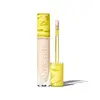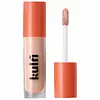Kosas Revealer Super Creamy + Brightening Concealer Versus Kulfi Main Match Crease-Proof Long-Wear Hydrating Concealer
What's inside
What's inside
 Key Ingredients
Key Ingredients

 Benefits
Benefits

 Concerns
Concerns

 Ingredients Side-by-side
Ingredients Side-by-side

Water
Skin ConditioningCaprylic/Capric Triglyceride
MaskingMica
Cosmetic ColorantOctyldodecanol
EmollientPolyglyceryl-2 Dipolyhydroxystearate
Skin ConditioningEthylhexyl Olivate
Skin ConditioningUndecane
EmollientGlycerin
HumectantPolyhydroxystearic Acid
EmulsifyingTridecane
PerfumingPolyglyceryl-3 Diisostearate
EmulsifyingGalactoarabinan
Helianthus Annuus Seed Wax
Skin ConditioningArnica Montana Flower Extract
MaskingCaffeine
Skin ConditioningDunaliella Salina Extract
Skin ConditioningFoeniculum Vulgare Oil
EmollientGlyceryl Oleate
EmollientHelianthus Annuus Seed Oil
EmollientLecithin
EmollientMaltodextrin
AbsorbentPalmitoyl Tripeptide-5
Skin ConditioningPanthenol
Skin ConditioningRosmarinus Officinalis Extract
AntimicrobialSodium Hyaluronate
HumectantSqualane
EmollientTocopherol
AntioxidantPotassium Sorbate
PreservativeSodium Benzoate
MaskingWater, Caprylic/Capric Triglyceride, Mica, Octyldodecanol, Polyglyceryl-2 Dipolyhydroxystearate, Ethylhexyl Olivate, Undecane, Glycerin, Polyhydroxystearic Acid, Tridecane, Polyglyceryl-3 Diisostearate, Galactoarabinan, Helianthus Annuus Seed Wax, Arnica Montana Flower Extract, Caffeine, Dunaliella Salina Extract, Foeniculum Vulgare Oil, Glyceryl Oleate, Helianthus Annuus Seed Oil, Lecithin, Maltodextrin, Palmitoyl Tripeptide-5, Panthenol, Rosmarinus Officinalis Extract, Sodium Hyaluronate, Squalane, Tocopherol, Potassium Sorbate, Sodium Benzoate
Water
Skin ConditioningEthylhexyl Palmitate
EmollientHydrogenated Poly(C6-14 Olefin)
EmollientPolyglyceryl-6 Pentaoleate
EmulsifyingCaprylic/Capric Triglyceride
MaskingCapryloyl Glycerin/Sebacic Acid Copolymer
Skin ConditioningGlycerin
HumectantSodium Chloride
MaskingSilica
AbrasiveCalcium Sodium Borosilicate
Ceresin
Emulsion StabilisingTocopherol
AntioxidantCrocus Sativus Flower Extract
MaskingEmblica Officinalis Fruit Extract
Skin ConditioningGlycyrrhiza Glabra Root Extract
BleachingRosa Canina Fruit Extract
AstringentHibiscus Sabdariffa Flower Extract
Skin ConditioningHelianthus Annuus Seed Oil
EmollientSesamum Indicum Seed Oil
EmollientBrassica Campestris Seed Oil
Skin ConditioningTriethoxycaprylylsilane
Propylene Carbonate
SolventStearalkonium Hectorite
Gel FormingPhenoxyethanol
PreservativeEthylhexylglycerin
Skin ConditioningPotassium Sorbate
PreservativeSodium Benzoate
MaskingCI 77891
Cosmetic ColorantIron Oxides
Water, Ethylhexyl Palmitate, Hydrogenated Poly(C6-14 Olefin), Polyglyceryl-6 Pentaoleate, Caprylic/Capric Triglyceride, Capryloyl Glycerin/Sebacic Acid Copolymer, Glycerin, Sodium Chloride, Silica, Calcium Sodium Borosilicate, Ceresin, Tocopherol, Crocus Sativus Flower Extract, Emblica Officinalis Fruit Extract, Glycyrrhiza Glabra Root Extract, Rosa Canina Fruit Extract, Hibiscus Sabdariffa Flower Extract, Helianthus Annuus Seed Oil, Sesamum Indicum Seed Oil, Brassica Campestris Seed Oil, Triethoxycaprylylsilane, Propylene Carbonate, Stearalkonium Hectorite, Phenoxyethanol, Ethylhexylglycerin, Potassium Sorbate, Sodium Benzoate, CI 77891, Iron Oxides
 Reviews
Reviews

Ingredients Explained
These ingredients are found in both products.
Ingredients higher up in an ingredient list are typically present in a larger amount.
This ingredient is an emollient, solvent, and texture enhancer. It is considered a skin-softener by helping the skin prevent moisture loss.
It helps thicken a product's formula and makes it easier to spread by dissolving clumping compounds.
Caprylic Triglyceride is made by combining glycerin with coconut oil, forming a clear liquid.
While there is an assumption Caprylic Triglyceride can clog pores due to it being derived from coconut oil, there is no research supporting this.
Learn more about Caprylic/Capric TriglycerideGlycerin is already naturally found in your skin. It helps moisturize and protect your skin.
A study from 2016 found glycerin to be more effective as a humectant than AHAs and hyaluronic acid.
As a humectant, it helps the skin stay hydrated by pulling moisture to your skin. The low molecular weight of glycerin allows it to pull moisture into the deeper layers of your skin.
Hydrated skin improves your skin barrier; Your skin barrier helps protect against irritants and bacteria.
Glycerin has also been found to have antimicrobial and antiviral properties. Due to these properties, glycerin is often used in wound and burn treatments.
In cosmetics, glycerin is usually derived from plants such as soybean or palm. However, it can also be sourced from animals, such as tallow or animal fat.
This ingredient is organic, colorless, odorless, and non-toxic.
Glycerin is the name for this ingredient in American English. British English uses Glycerol/Glycerine.
Learn more about GlycerinHelianthus Annuus Seed Oil is the oil derived from the seeds of a Sunflower. Sunflower seed oil is non-fragrant. It is an emollient, meaning it helps to soften the skin.
Sunflower seed oil contains many fatty acids. The fatty acids found in sunflower seeds include (from highest amount to least): linoleic acid, myristic acid, palmitic acid, stearic acid, arachidic acid, oleic acid, and linolenic acid.
These fatty acids help the skin create ceramides. Ceramides play a role in repairing the skin barrier.
Helianthus Annuus Seed Oil helps moisturize the skin. This in turn helps the skin look more rejuvenated and smoother.
Sunflowers are rich in vitamin E.
Historians believe Indigenous cultures of North America domesticated sunflowers before corn. Thus they relied on sunflower oil for a variety of uses. One such use is moisturizing skin and hair.
Sunflower seed oil may not be fungal acne safe. We recommend speaking with a professional if you have any concerns.
Learn more about Helianthus Annuus Seed OilPotassium Sorbate is a preservative used to prevent yeast and mold in products. It is commonly found in both cosmetic and food products.
This ingredient comes from potassium salt derived from sorbic acid. Sorbic acid is a natural antibiotic and effective against fungus.
Both potassium sorbate and sorbic acid can be found in baked goods, cheeses, dried meats, dried fruit, ice cream, pickles, wine, yogurt, and more.
You'll often find this ingredient used with other preservatives.
Learn more about Potassium SorbateSodium Benzoate is a preservative. It's used in both cosmetic and food products to inhibit the growth of mold and bacteria. It is typically produced synthetically.
Both the US FDA and EU Health Committee have approved the use of sodium benzoate. In the US, levels of 0.1% (of the total product) are allowed.
Sodium benzoate works as a preservative by inhibiting the growth of bacteria inside of cells. It prevents the cell from fermenting a type of sugar using an enzyme called phosphofructokinase.
It is the salt of benzoic acid. Foods containing sodium benzoate include soda, salad dressings, condiments, fruit juices, wines, and snack foods.
Studies for using ascorbic acid and sodium benzoate in cosmetics are lacking, especially in skincare routines with multiple steps.
We always recommend speaking with a professional, such as a dermatologist, if you have any concerns.
Learn more about Sodium BenzoateTocopherol (also known as Vitamin E) is a common antioxidant used to help protect the skin from free-radicals and strengthen the skin barrier. It's also fat soluble - this means our skin is great at absorbing it.
Vitamin E also helps keep your natural skin lipids healthy. Your lipid skin barrier naturally consists of lipids, ceramides, and fatty acids. Vitamin E offers extra protection for your skin’s lipid barrier, keeping your skin healthy and nourished.
Another benefit is a bit of UV protection. Vitamin E helps reduce the damage caused by UVB rays. (It should not replace your sunscreen). Combining it with Vitamin C can decrease sunburned cells and hyperpigmentation after UV exposure.
You might have noticed Vitamin E + C often paired together. This is because it is great at stabilizing Vitamin C. Using the two together helps increase the effectiveness of both ingredients.
There are often claims that Vitamin E can reduce/prevent scarring, but these claims haven't been confirmed by scientific research.
Learn more about TocopherolWater. It's the most common cosmetic ingredient of all. You'll usually see it at the top of ingredient lists, meaning that it makes up the largest part of the product.
So why is it so popular? Water most often acts as a solvent - this means that it helps dissolve other ingredients into the formulation.
You'll also recognize water as that liquid we all need to stay alive. If you see this, drink a glass of water. Stay hydrated!
Learn more about Water